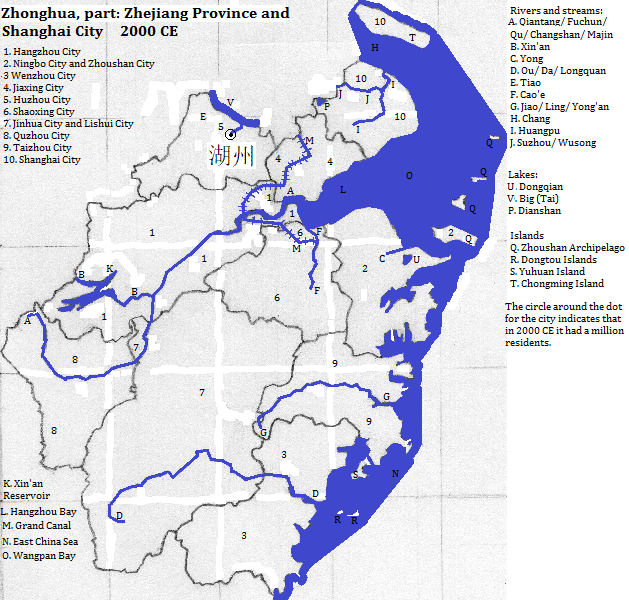湖州 (Húzhōu)
湖州1 (Húzhōu) is a city centered where the Tiao River meets the Chángxīng-Húzhōu-Shànghăi Canal, about ten kilometers south of Great Lake (Tai Hu), in 浙江2 (Zhèjiāng) Province, in 中华3 (Zhōnghuá) People's Republic. Only in the 20th century did its population grow so large (metropolitan population of 1.293 million).4 The tallest two buildings (as of early winter 2016) are the East and West towers of the Soochow International Plaza (945 feet. 2014). An unusual building is the hoop-shaped, mesh-textured, Sheraton Huzhou Hot Spring Resort on Lake Tai. "The hotelís ring shape enables all rooms to have balconies and views, and receive daylight from all directions."5
Tourists like Nánxún Ancient Town, a subordinate city (shi).6 UNESCO honors, as part of a World Heritage Site, the Nánxún section of the previous main course of the Jiangnan Canal.
| Year | Population | Political entity |
| 2000 CE | 1,145,0007| 中华 (Zhōnghuá or Chinese) People's Republic) | |
Historical Map

External references
A lake-side resort within Húzhōu, Zhèjiāng Province, Zhōnghuá People's Republic
Footnotes
1. Húzhōu or Hu-chou or Hujou are transliterations from Pŭtōnghuà Chinese. The first character means lake and the second refers to an administrative division, usually translated as either province, prefecture or county. In the Huzhou dialect of the Wu dialect group it transliterates as Vuciu.
2. Zhèjiāng or Che-Chiang or Jejyang in transliterated Pŭtōnghuà Chinese. It is also called Chekiang (former postal designation based on the Nanjing dialect). The first character is a phonetic marker coupled with the water radical. In reconstructed Old Chinese it was pronounced like tet, and was a proto-Wu term for the Yue people according to https://en.wikipedia.org/wiki/Zhejiang, accessed August 10, 2016. The second character means river.
3. Zhōnghuá or Chung-hua or Junghwa in transliterated Pŭtōnghuà Chinese. The first character means central and the second means Chinese/ illustrious/ flowery. China is its English name. In the Wu dialect group it transliterates as Tsonkoh.
4. The shi had 2.894 million according to the 2010 census. Omitting the three xiàn reduces this to 1.293 million. (2010 census figures are from https://en.wikipedia.org/wiki/Huzhou, accessed July 31, 2016.)
5. Information about buildings is from emporis.com, accessed Dec. 8, 2016.
6. Tourist sites for the province are from two sites: http://www.china.org.cn/top10/2012-06/04/content_25538813.htm (Zhejiang tourism, accessed August 3, 2016)--for the first five only as the rest errored out, and these were really the top five as the list was backward-ordered; however the first one (that is, number ten) was eliminated. The rest are from https://www.tripadvisor.com/Attractions-g297468-Activities-Zhejiang.html--the top five, accessed August 3, 2016.
7. https://www.citypopulation.de/php/china-zhejiang-admin.php (accessed Aug. 2, 2016) provided the prefectural and sub-prefectural populations for 2000. https://en.wikipedia.org/wiki/List_of_administrative_divisions_of_Zhejiang, accessed on the same date provided the list of administrative changes 2000 to date, but none were relevant to Húzhōu. Excluding the same three xiàn as 2010 brings the metropolitan population down to 1.145 million, with the shi without exclusions having 2.626 million in 2000 CE.

